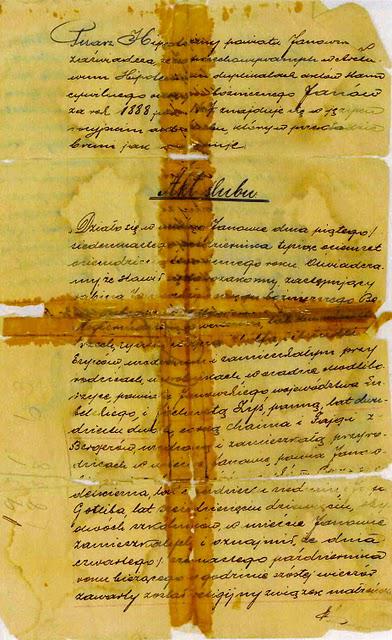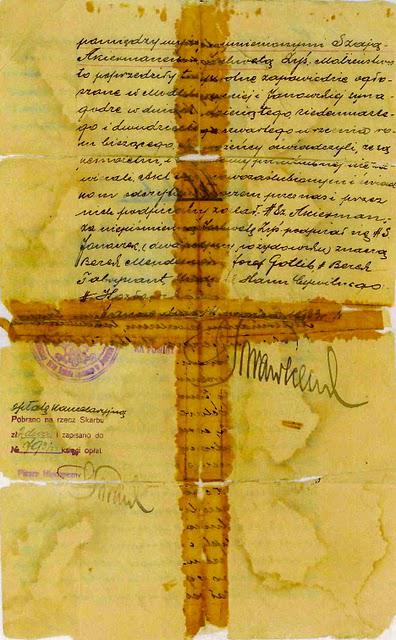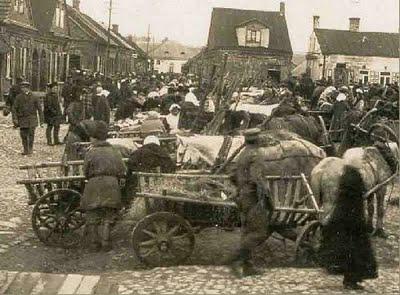We finally found a Polish speaker who translated the title. It was a marriage certificate (Akt Slubu), signed and sealed long ago in the faraway town of Modle-Borzyce (pronounced Masel-Budgets) in southern Poland, far away from upstate New York, USA. It could have been from another planet.

Click on the image to expand to full size.
What was the point of these rotting old pages? Somebody, in fact several people -- parents, grand parents, great grandparents - clearly had made a huge effort to hold onto them, carrying them across the Atlantic Ocean when the family emigrated to the US, keeping them safe during decades of poverty, and passing them down now to three generations over a span of 120 years. Still, this was no fancy certificate to frame and put on a wall. And a Jewish wedding, even back in autocratic Russian-dominated pre-independence Poland, needed no official government stamp to be recognized in the Shtetl. Who would care?
Jews in Poland back then had rules on these things. Children were not allowed to chose their own husbands or wives. Instead, it was the parents who arranged marriages for them, often when the children were barely in their teens. A family hired a matchmaker (or yentl) who made sure that rich daughters married rich husbands, poor daughters married poor husbands, and so on.
Yetta and Sheah broke this rule. They refused to wait for a yentl. They fell in love.

Madle-Borzyce town square on market day, late 1800s.
Modle-Borzyce in the 1880s was a tiny hamlet of about 900 people, made up of small buildings around a square that served as a marketplace once a week. Young Sheah Akierman came to the Zys home one day around 1887, apparently on business, to fix someone's shoes. He was amazed at what he saw. "My father was a good looking young man, blond and blue-eyed," my Aunt Rachel (Sheah's daughter) wrote about him years ago. "The first time he came to visit my mother's house he was so shocked he couldn't move. He had never seen such a rich house. All the walls were covered with mirrors and paintings."Then he laid eyes on the rich doctor's beautiful daughter. She happened to come in at that moment while he was standing in a corner. He remembered her wearing a white ermine coat and carrying a white muff in her hands. "He told me that he'd never seen such a beautiful girl," my Aunt Rachel went on. "He fell in love with her immediately. The next time he saw her was at their wedding."
But it wasn't so easy. Love mattered back then, but not very much. We don't know what actually happened behind closed doors -- the arguments, the threats, the diplomacy, the shrill voices. Why did Dr. Chaim Zys finally relent and permit his beautiful daughter to marry a penniless cobbler? It's a mystery, but somehow, Yetta and Sheah had insisted on having their way, on demanding their own choice in who they marry, and they were stubborn enough to win.
"If anybody got married the ceremony was in the square under the stars," my Aunt Rachel wrote of Modle-Borzyce. "The whole town -- the Jewish part -- went to the wedding. Everyone came even if they were not relatives." So it was with Yetta and Sheah Akierman.
They had their beautiful day, but life for them would then prove terribly hard. "My mother started with a dowery of jewels and furs but these items soon disappeared as they had one child after another," Rachel wrote. They would have seven children altogether. Sheah, always described as outgoing, generous, and surrounded by friends, could never hold jobs very long. Reaching New York City in 1908, they were poor even by lower East Side standards. The family lived for years in a 5th-floor walk-up apartment with no hot water and only a coal stove for heat. Yetta and the little children had to carry the coal by hand in pails from the basement up the six flights of stairs. For money, Sheah did everything from cobbling shoes to selling goods from a pushcart to making whiskey on the kitchen stove (it was during Prohibition) to sell for a few dollars.
These were tough times, but though it all, they had their lodestar -- those two yellowed, ink-stained pieces of paper, the Akt Slubu or marriage certificate. It was their reminder of the love story that had cemented their marriage, proven their commitment, and made it possible to carry the later burdens.
These were my father's-side grandparents, Sheah and Yetta Ackerman. Sheah died before I was born and Yetta when I was far too young to remember her. Their youngest son, Bill, my father, born just before leaving Poland but raised in America, would establish himself as a lawyer in depression-era New York City and ultimately move our family to the relative splendor of upstate Albany (about 150 miles north of NYC). He too held on to that old Polish marriage certificate, passed down from his parents, for the rest of his life, though he never mentioned it or showed it to us. When he and my mother died years ago, these old scraps of paper landed in an ignored folder in my sister's house. By then, they'd been forgotten.
Until now. There's value in these mysterious old things - especially the ones that people hold on to at all costs. They tell the best stories, and remind us of their best sides.
Confused about the dates? Here's the math: I was born in 1951, the youngest child in our family, when my father, Bill Ackerman, was 44 years old. He was born in 1907. My father, in turn, was the youngest child of Sheah/Sam Ackerman, born when his father also was about 40 years old. As a result, Sheah, my Grandfather, was born in 1867 -- two years before Ulysses Grant became president of the USA. If you ever wonder why I'm a history fanatic, think of how close you are in age to your own grandparents, then try wrapping your head around this little calculation.
My Aunt Rachel compiled her family memories in a quirky, funny, self-published little book called Horseradish: Jewish Roots. It's a great read. In a perfect world, it would be a best seller.
Visit modern Modle-Borzyce on this very cool road trip through the neighborhood, courtesy of YouTube--



COMMENTS ( 1 )
posted on 12 May at 13:51
Charming story. I adore family history